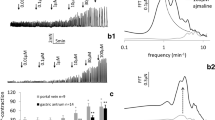Abstract
-
1.
Pharmacological properties of the neuromuscular junction in the isolated hypogastric nerve-vas deferens preparation of the guinea-pig were studied using the sucrosegap technique.
-
2.
Earlier observations concerning the ineffectiveness of α-adrenergic blocking agents on transmission were confirmed.
-
3.
Noradrenaline exerted a dual influence on the nerve-mediated contraction, i.e. inhibitory at a low concentration (10−8 to 10−7 g/ml) but potentiating at a higher concentration.
-
4.
Noradrenaline invariably reduced the size of the excitatory junction potential (EJP) without altering the resting potential. This effect was not blocked by β-adrenergic blocking agents. The inhibitory action of a low concentration of noradrenaline may be accounted for by this EJP-suppressing effect.
-
5.
In the presence of an α-adrenergic blocking agent, noradrenaline reduced the height of nerve-induced contraction even at a high concentration. This is explained by the selective blocking of the potentiating effect without altering the EJP-depression.
-
6.
Tyramine reduced the height of nerve-mediated contraction.
-
7.
These experimental results can consistently be explained by assuming the presence of two different kinds of adrenergic receptors in the vas deferens, ‘junctional’ and ‘extrajunctional’. While the extrajunctional receptors are typical α-type receptors, the junctional receptors are resistant to both α- and β-blocking agents, and seem to be desensitized by noradrenaline.
-
8.
The K+-contracture was also reduced in size by the combination of dibenamine and noradrenaline. The assumption that the transmitter released from depolarized nerve-endings would contribute to the height of K+-contracture was substantiated by experiments using reserpinized vas deferens.
Similar content being viewed by others
References
S. Huković,Responses of the Isolated Sympathetic Nerve Ductus Deferens Preparation of the Guinea-Pig, Br. J. Pharmac.16, 188–194 (1961).
G. Burnstock andM.E. Holman,Junction Potentials at Adrenergic Synapses, Pharmac. Rev.18, 481–493 (1966).
G. Burnstock andM.E. Holman,The Transmission of Excitation from Autonomic Nerve to Smooth Muscle, J. Physiol.155, 115–133 (1961).
H. Kuriyama,Electrophysiological Observations on the Motor Innervation of the Smooth Muscle Cells in the Guinea-Pig Vas Deferens, J. Physiol.169, 213–228 (1963).
A.T. Birmingham andA.B. Wilson,Preganglionic and Postganglionic Stimulation of the Guinea-Pig Isolated Vas Deferens Preparation, Br. J. Pharmac.21, 569–580 (1963).
M.E. Holman andA. Jowett,Some Actions of Catecholamines on the Smooth Muscle of the Guinea-Pig Vas Deferens, Austral. J. exp. Biol.42, 40–53 (1964).
R.P. Ahlquist,A Study of the Adrenergic Receptive Mechanism of Canine Ileum, Am. J. Physiol.153, 586–599 (1948).
B.J. Large,Sympathetic β-Receptors and the Guinea-Pig Vas Deferens, Br. J. Pharmac.24, 194–204 (1965).
K. Takagi andI. Takayanagi,β-Adrenergic Receptor on the Vas Deferens of the Guinea-Pig, Nature206, 308–309 (1965).
Y. Hotta,Dual Action of Noradrenaline on the Guinea-Pig Vas Deferens, Folia Pharmac. Japon.62, 134 § (1966).
E. Bülbring andG. Burnstock,Membrane Potential Changes Associated with Tachyphylaxis and Potentiation of the Response to Stimulating Drugs in Smooth Muscle, Br. J. Pharmac.15, 611–624 (1960).
S. Thesleff,The Mode of Neuromuscular Block Caused by Acetylcholine, Nicotine, Decamethonium and Succinylcholine, Acta physiol. scand.34, 218–231 (1955).
S. Thesleff,The Effects of Acetylcholine, Decamethonium and Succinylcholine on Neuromuscular Transmission in the Rat, Acta physiol. scand.34, 386–392 (1955).
B. Katz andS. Thesleff,A Study of the ‘Desensitization’ Produced by Acetylcholine at the Motor End-Plate, J. Physiol.138, 63–80 (1957).
N.O. Sjöstrand,Effect of Reserpine and Hypogastric Denervation on the Noradrenaline Content of the Vas Deferens and the Seminal Vesicle of the Guinea-Pig. Acta physiol. scand.56, 376–380 (1962).
C.B. Ferry,The Innervation of the Vas Deferens of the Guinea-Pig, J. Physiol.166, 16p (1963).
G.A. Bentley,Potentiation of Responses to Noradrenaline and Reversal of Sympathetic Nerve Blockade in the Guinea-Pig, Br. J. Pharmac.25, 243–256 (1965).
A. Sakuma, Y. Nonomura, H. Kanamura andM. Otsuka,Pharmacological Evidence for the Existence of Sympathetic Ganglia in the Vicinity of the Vas Deferens of Guinea-Pigs, Jap. J. Pharmac.15, 357–361 (1965).
G. Burnstock andM.E. Holman,Effect of Denervation and of Reserpine Treatment on Transmission at Sympathetic Nerve Endings, J. Physiol.160, 461–469 (1962).
G. Burnstock andM.E. Holman,An Electrophysiological Investigation of the Action of Some Autonomic Blocking Drugs on Transmission in the Guinea-Pig Vas Deferens, Br. J. Pharmac.23, 600–612 (1964).
C.C. Chang andJ.C. Chang,A Change in the Subcellular Distribution of Noradrenaline in the Rat Isolated Vas Deferens Effected by Nerve Stimulation, Br. J. Pharmac.25, 758–762 (1965).
B. Falck,Observations on the Possibilities of Cellular Localization of Monoamines by a Fluorescence Method, Acta physiol. scand.56 (suppl. 197), 6–25 (1962).
M. Nickerson,Drugs Inhibiting Adrenergic Nerves and Structures Innervated by Them, inThe Pharmacological Basis of Therapeutics, 3rd ed. (L. S. Goodman and A. Gilman; Macmillan Company, New York 1965), p. 546–577.
J.N. Langley,The Effect of Various Poisons upon the Response to Nervous Stimuli Chiefly in Relation to the Bladder, J. Physiol.43, 125–181 (1911).
G. Burnstock andG. Campbell,Comparative Physiology of the Vertebrate Autonomic Nervous System. I. Innervation of the Urinary Bladder of the Toad (Bufo Marinus), J. exp. Biol.40, 421–436 (1963).
G. Burnstock, J. O'Shea andM. Wood,Comparative Physiology of the Vertebrate Autonomic Nervous System. II. Innervation of the Urinary Bladder of the Ringtail Possum (Pseudo Cheirus Peregrinus), J. exp. Biol.40, 403–419 (1963).
G.B. Chesher andR.H. Thorp,The Atropine-Resistance of the Response to Intrinsic Nerve Stimulation of the Guinea-Pig Bladder, Br. J. Pharmac.25, 288–294 (1965).
W.D.M. Paton andW.L.M. Perry,The Relationship Between Depolarization and Block in the Cat's Superior Cervical Ganglion, J. Physiol.119, 43–57 (1953).
W.D.M. Paton,A Theory of Drug Action Based on the Rate of Drug-Receptor Combination, Proc. R. Soc. Lond. [B]154, 21–69 (1961).
R.F. Furchgott, W. Sleater andT. de Gubareff,Effects of Acetylcholine and Epinephrine on the Contractile Strength and Action Potential of Electrically Driven Guinea-Pig Atria, J. Pharmac.129, 405–416 (1960).
F. Bauman, L. Girardier andJ.M. Posternak,Effects Inotropes de l'Acétylcholine sur le Myocarde, Helv. Physiol. Pharmac. Acta18, 509–522 (1960).
Author information
Authors and Affiliations
Rights and permissions
About this article
Cite this article
Hotta, Y. Some properties of the junctional and extrajunctional receptors in the vas deferens of the guinea-pig. Agents and Actions 1, 13–21 (1969). https://doi.org/10.1007/BF01977661
Received:
Revised:
Issue Date:
DOI: https://doi.org/10.1007/BF01977661




